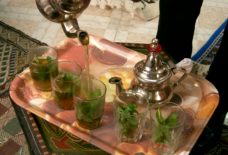Knafeh: The Savory Sweet From Palestine
The Palestinian city of Nablus in the Israeli occupied West Bank has long been a center of Palestinian culture and remains the largest Palestinian city between the Jordan River and the Mediterranean Sea.
Known in the Bible as Shechem, the Romans called it Neapolis and the 7th century Arab conquerors Arabicized it to Nablus.
Ask a Nablusi what Nablus is famous for and you’ll likely hear two things: soap and Knafeh. The city’s olive oil soap is legendary, but the more than 30 soap factories in the 19th century have dwindled down to a tiny industry. As for Knafeh, the pasty remains both popular and a Nablusi trademark. While Knafeh is prepared throughout the Levant, it is Nablus that remains famous for it and the city even made it into the Guinness World Record with the largest Knafeh ever weighing in at 2,976 lbs.
The dessert is simple enough and a quick Google search will turn up many recipes. Unsalted goat cheese is layered between two layers of shredded semolina dough called Kadaifi. Add food coloring on top for the orange look. After baking, pistachios (or almonds) and sugar syrup are drizzled over. Although simple to prepare, the taste is dynamic between the soft warm cheese and the moist dough topped with fragrant syrup that combine to produce a savory, sweet mix in every bite.
For Nablusis, Knafeh is more than just a dessert, but a pleasant (and hefty) street food consumed at all times of the day akin to, say, Falafel.
Nablus is home to many Knafeh bakers, but it is the Helowiat Al-Aqsa shop in the city’s 200-hundred year old quarter, home to the Souk, that sets the standard (Helowiat is Arabic for sweets and Al-Aqsa is the mosque next to the Dome of the Rock in Jerusalem’s Old City).
People eagerly line up along the Ottoman-built walls for another fresh, warm tray of Knafeh. And if you ever head to Nablus you better get there quick, storefronts sell out quick.
The origin of the Knafeh may date back to the time of the Abbasid Caliphate in 9th century Baghdad. Gil Marks, author of “Encyclopedia of Jewish Food,” writing about the “early adoption and production of this pastry by the Jewish community,” relates how the Caliphs’ cooks made a “crepe-like” pastry called qata’if wrapped around almond cream and drizzled with honey. By the 13th century, Middle Eastern cooks began to bake “thinly sliced … qata’if and tossed the shreds with honey,” but the preparation was later modified whereby the qata’if batter was poured “into thin lines onto the metal sheet.” This new method of cooking the dough became known as Kadayif or Knafeh, a variation of the word qata’if. Now you know.
So what if you live stateside and don’t particularly like to bake? From Brooklyn’s Tanoreen restaurant to northern Virginia’s Jenin Pastry to the appropriately named Knafeh Café in Anaheim, California, the Knefah has made it to America.
Institute for Palestine Studies
BuzzFeed


